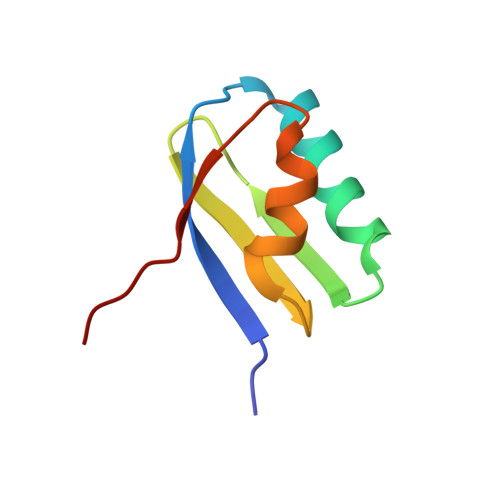Structural basis for metal binding specificity: the N-terminal cadmium binding domain of the P1-type ATPase CadA
Banci, L., Bertini, I., Ciofi-Baffoni, S., Su, X.-C., Miras, R., Bal, N., Mintz, E., Catty, P., Shokes, J.E., Scott, R.A.(2006) J Mol Biol 356: 638-650
- PubMed: 16388822
- DOI: https://doi.org/10.1016/j.jmb.2005.11.055
- Primary Citation of Related Structures:
2AJ0, 2AJ1 - PubMed Abstract:
In bacteria, P1-type ATPases are responsible for resistance to di- and monovalent toxic heavy metals by taking them out of the cell. These ATPases have a cytoplasmic N terminus comprising metal binding domains defined by a betaalphabetabetaalphabeta fold and a CXXC metal binding motif. To check how the structural properties of the metal binding site in the N terminus can influence the metal specificity of the ATPase, the first structure of a Cd(II)-ATPase N terminus was determined by NMR and its coordination sphere was investigated by X-ray absorption spectroscopy. A novel metal binding environment was found, comprising the two conserved Cys residues of the metal binding motif and a Glu in loop 5. A bioinformatic search identifies an ensemble of highly homologous sequences presumably with the same function. Another group of highly homologous sequences is found which can be referred to as zinc-detoxifying P1-type ATPases with the metal binding pattern DCXXC in the N terminus. Because no carboxylate groups participate in Cu(I) or Ag(I) binding sites, we suggest that the acidic residue plays a key role in the coordination properties of divalent cations, hence conferring a function to the N terminus in the metal specificity of the ATPase.
Organizational Affiliation:
Magnetic Resonance Center CERM and Department of Chemistry, University of Florence, Via Luigi Sacconi 6, 50019 Sesto Fiorentino, Florence, Italy.














